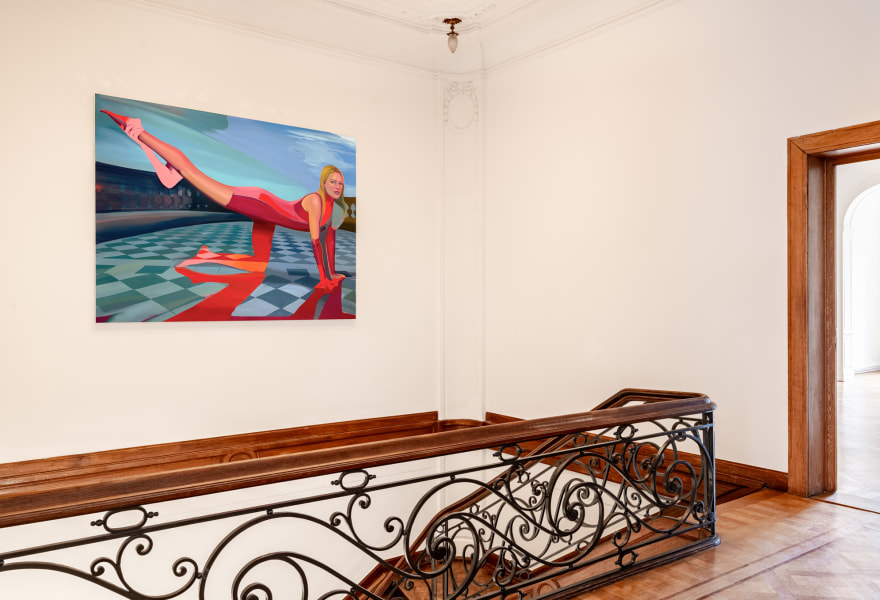11 june 2024, Yves Joris
Lizzy Lunday: Introduction to the modern myth
At GNYP Gallery in Antwerp, American artist Lizzy Lunday is presenting her intriguing exhibition with the cryptic title New Myths and Amalgamated Monsters. The exhibition, which runs until 22 June 2024, offers art lovers a unique opportunity to experience how Lunday's work blends historical and contemporary references into a visual spectacle. Her paintings invite reflection on the human psyche and our contemporary society through a unique fusion of art from the past and present.
A brief introduction
Lizzy Lunday, born in 1992 in Kansas City, is a name to reckon with in the contemporary art world. She earned her Master of Fine Arts in 2019 from the renowned Pratt Institute and has since gained international acclaim with paintings that blur the boundaries between reality and fiction. Lunday's work has been featured in numerous solo and group exhibitions and she has received various awards for her bold and experimental approach to painting. Her style is characterised by a dreamy, almost surreal aesthetic that often integrates mythological and religious themes in a contemporary context.

Lizzy Lunday, New Myths and Amalgamated Monsters, GNYP Gallery
The creation of new myths
Lunday’s paintings are a fascinating amalgamation of mythological and religious references with contemporary images. In this exhibition, she invites the viewer to reflect on the universal themes central to her work. Lunday's works envelop themselves with a mysterious aura. A striking piece is On the Way Out, in which she gives a modern twist to Masaccio's Expulsion from the Garden of Eden. Instead of the intense emotional charge and guilt of Adam and Eve, Lunday shows an almost nonchalant couple leaving a restaurant or TV studio. This reinterpretation emphasises the tension between our public facades and private vulnerabilities, a theme that remains relevant through the ages.
Even more compelling is her work Slipping, in which she immerses the viewer in a colourful, vibrant scene offering a contemporary interpretation of human interaction. The composition captures a moment of chaos and vulnerability, an intriguing combination of figures caught in an apparently uncontrolled and absurd situation. The dynamics and incongruity of the scene evoke the dramatic liveliness of a reality show in which personal relationships and public performances collide and merge. Her colour palette is both bold and expressive, with saturated shades of pink, yellow and green outlining the figures and giving the scene a sense of plasticity. The figures seem to balance on the edge of physical and emotional collapse, their bodies twisted and contorted in uncomfortable positions. This playful distortion and dynamic poses create a sense of both movement and instability, as if they could fall or rise at any moment.

Lizzy Lunday, Slipping, GNYP Gallery
Playful reference to Caravaggio
Slipping also subtly recalls the iconic painting The Entombment of Christ (1602). Just as in Caravaggio's masterpiece in which the figures are dramatically illuminated and caught in a moment of intense emotion and physical expression, Slipping shows a modern scene of rapture and doom. The central figure, supported by the others, seems trapped in a fragile pose, similar to the vulnerable Christ figure being carried to his grave by his followers. The lighting and shadows in Lunday's painting, though less realistic and more stylised than Caravaggio's, contribute to the drama and urgency of the scene. The bodies are not so much a representation of physical pain, but rather a manifestation of the complex emotions and social dynamics of contemporary society.
The complexity of intimacy and desire
Lunday is known for exploring the boundary between reality and fiction in her paintings. Her paintings are like a dream world in which foregrounds and backgrounds merge and bodies are transformed into new, mutated forms. As a viewer, you feel like a witness to a visual conflict between the real and the virtual. Another recurring theme in Lunday's work is the complex nature of intimacy and desire. In her paintings, she explores the gap between idealised media representations of intimacy and its often uncomfortable reality. The figures in her work are in moments of apparent closeness, suffused with tension and ambiguity.
In Beheaded, the gestures of the figures balance between tenderness and territorial behaviour, depicting intimacy as a matter of definition rather than a fixed fact. This exploration of intimacy is particularly relevant in an era in which the line between public and private lives is increasingly blurred. Lunday’s works invite the viewer to explore the underlying emotions and relationships, without ever revealing all their secrets. This creates a dynamic in which the viewer is actively involved in deciphering the meanings and themes in her art.

Lizzy Lunday, Beheaded, GNYP Gallery
… of familiarity and disquiet
Lizzy Lunday's exhibition offers us a rich visual experience that feels both familiar and disturbingly new. Her work invites us to reflect on how historical and contemporary images shape our perception of the world and how the complex nature of human relationships unfolds in this context. With her bold use of color, exploration of deep emotional themes and unique ability to integrate timeless archetypes into a contemporary context, the artist offers a fascinating look at the human experience. Her paintings continue to challenge and fascinate us, establishing her as an important voice in the contemporary art world. For art lovers and critics, this exhibition is a must-see, an opportunity to explore the future of painting through the lens of an artist who continues to defy and redefine conventions.

Lizzy Lunday, New Myths and Amalgamated Monsters, GNYP Gallery
